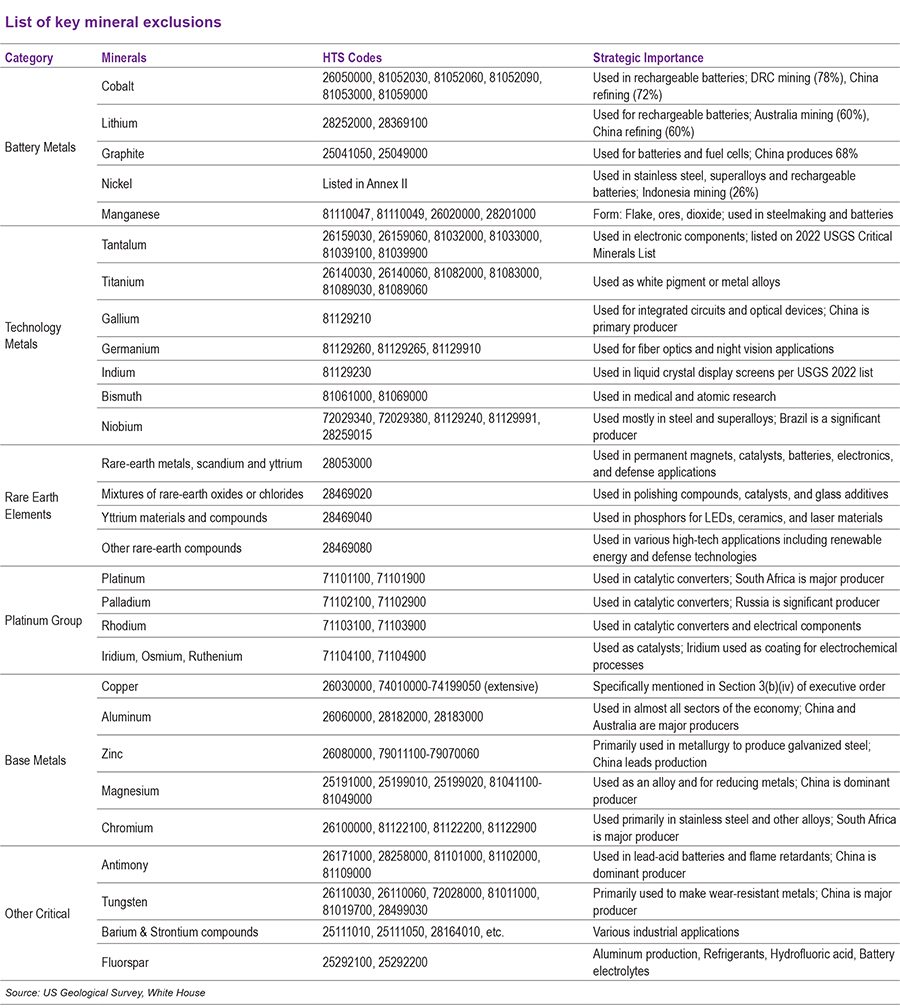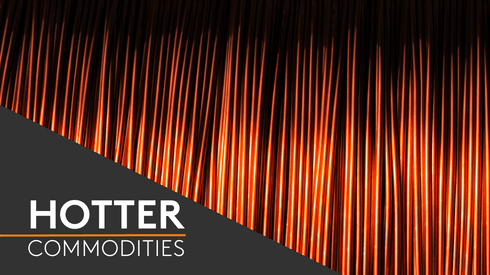Critical minerals appear to be exempt from the “reciprocal” tariffs introduced by US President Donald Trump on Wednesday April 2; however, uncertainty remains amid ongoing policy volatility, market participants reported.
Trump signed a sweeping executive order on Wednesday implementing a new “reciprocal tariff” policy that will impose additional duties on imports from most global trading partners, beginning at 10%, with higher rates for specific nations.
According to the executive order’s Annex I, China will face a 34% reciprocal tariff rate, while Vietnam and Cambodia will see even higher rates at 46% and 49% respectively. EU imports will be subject to a 20% tariff, with Japan at 24% and India at 27%.
The April 2 executive order, which declares a national emergency over “large and persistent” US trade deficits, specifically exempts “certain critical minerals” through Section 3(b). This carve-out reflects America’s dependence on foreign sources for materials considered essential to manufacturing, defense and emerging technologies.
The new tariffs take effect on April 5, with country-specific higher rates following on April 9. The White House cited a 40% increase in US goods trade deficits over the past five years, reaching $1.2 trillion in 2024, as justification for the emergency action.
The mineral exemptions represent a strategic decision to maintain access to raw materials needed for domestic manufacturing, even as the administration seeks to rebalance global trade flows through broader import restrictions.
List of key mineral exclusions
The table below categorizes select key minerals excluded from the April 2025 reciprocal tariff, organized by their primary industrial applications.
These exclusions align substantially with the US Geological Survey’s (USGS) 2022 Critical Minerals List, according to the White House.

Cobalt market participants unsurprised
The cobalt market was on the fence about the latest tariff announcement by Trump. Some remained optimistic about cobalt being exempted from the tariffs, while others said they were expecting it and were not surprised.
“I would say there was no real impact on the US market as cobalt and nickel metal are exempt, but not great for the world. I think maybe demand in Europe will improve as the US remains unpredictable,” a market participant said.
“We were expecting something like that. It would be stupid for the US to put tariffs on cobalt given they do not produce any and consume a lot. We were expecting that there would be waivers,” a second participant told Fastmarkets.
It remains to be seen whether Indonesian cobalt metal will be subjected to duties as a part of Trump’s baseline tariff on all nations. China-backed Lygend Mining is one of the major producers of cobalt in Indonesia, which does not face US tariffs so far and has emerged as an increasingly important source of cobalt in recent years.
“There is some ambiguity whether Indonesia comes under the 10% blanket tariffs. It looks like April 5 blanket tariffs might apply to all nations and commodities,” a third source said.
Minor metals market relieved
Minor metal market participants in the US breathed a sigh of relief, as many minor metals already wracked by trade barriers and tariffs were excluded from the reciprocal tariffs.
Metals such as indium, gallium and bismuth, for example, are covered under Section 301 tariffs, meaning imports from China, the world’s largest producer of all three, are already subject to a 25% import duty going into the US.
Trump’s additional 20% tariff on all imports from China, announced earlier in February, brings that effective rate to 45%, and reciprocal tariffs of 34% on Chinese imports would have brought the effective rate to 79% if the exclusion had not been introduced.
“That would have been the straw that threatened the continuation of production for downstream producers,” a North American minor metal expert told Fastmarkets.
Antimony also exempt from new US tariffs
Antimony is classified as a critical raw material by the US, as well as multiple other regions, including Europe, Canada, Australia, India and China.
It was not included in previous US tariff rounds and has once again been exempted from the latest tariffs announced on Wednesday — a decision widely anticipated by market participants.
“It’s not surprising that antimony is exempt, given how heavily reliant the US is on imports. There is no domestic production, and it’s an important metal for their industry and military,” an antimony trader said.
Despite having significant antimony reserves, the US remains dependent on imports to meet its supply needs.
However, uncertainty still lingers in the market.
“Regardless of whether antimony is exempt, we’re currently seeing widespread reluctance to offer new shipments to the US, partly due to the major policy uncertainty surrounding this trade war,” the trader added.
“Trump is increasingly unpredictable, and I was definitely worried when I saw the news. Some of my customers are still trying to figure out whether a tariff applies,” a second antimony trader said.
“If Trump were to impose a tariff on antimony, it would be catastrophic for US industries that rely on it — particularly lead batteries, ammunition and antimony trioxide. These industries are already struggling to pass costs up through the value chain,” the trader added.
The second trader believed the news would have limited market impact, aside from some customers preferring to take delivery earlier in case a tariff is introduced later.
“The US needs antimony — how could they impose tariffs on it?” an antimony producer said.
Fluorspar: ‘Not too much has changed overnight’
Fluorspar is designated as a critical raw material by the US with key usages in chemicals, refrigerant gases and aluminium production.
Mexico ranks among the top three largest producers of fluorspar globally, with China being the main producer.
Mexico avoided the fresh round of tariffs announced by Trump on April 2, with market participants in the US welcoming the reprieve that critical raw materials look to be exempt from, in light of the far-reaching round of new tariffs.
“It’s bad for the wider economy that these tariffs are coming in, but with fluorspar exempt from the duties, not too much has changed overnight,” one US market participant said.
The US imported 269,700 tonnes of fluorspar in 2024 from Mexico, accounting for 66.77% of total US imports of fluorspar in that period, according to USGS data.
Canada and Mexico are already subject to separate tariff actions related to border security issues, and the new reciprocal tariffs would not stack on top of those existing tariffs. If the border security tariffs are removed, then special rules would apply for the two markets.
Rapid changes to the tariff regime faced by the US’s neighbors has sparked concern about what charges will be imposed on their exports.
Chemical company Orbia, which owns the world’s largest fluorspar mine in Mexico, said in a statement back in January: “There is a ton of complexity around the tariffs that the US is imposing against Mexico. That said, we are doing everything we can to be nimble and scenario plan.”
While market participants have expressed relief over critical mineral exemptions, there remains considerable confusion about how the old and new tariff regime will function together in practice.
“The 10% ad valorem tax is applied, except for goods that fall under tariff lines in Annex II or goods that are already covered by previous tariffs,” a legal analyst of the International Energy Agency told Fastmarkets. ““The Liberation Day tariffs do not apply to Canada and Mexico, which continue to fall under previous executive orders (Imposing Duties To Address the Situation at Our Southern Border).”
The analyst referred to Section 3(b) of the executive order, which specifically exempts certain critical minerals, and Sections 3(d) and 3(e), which outline special provisions for Canada and Mexico.





